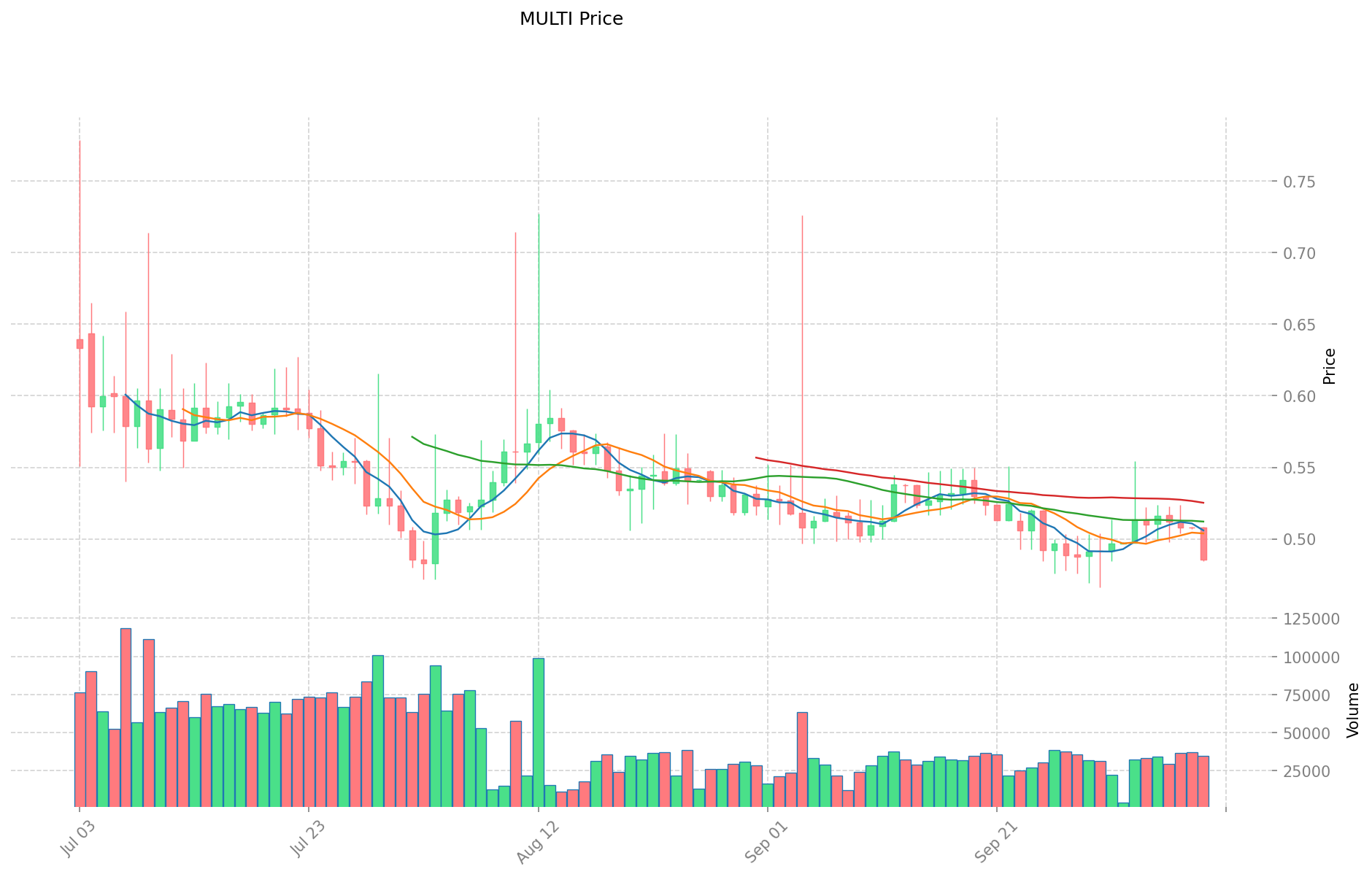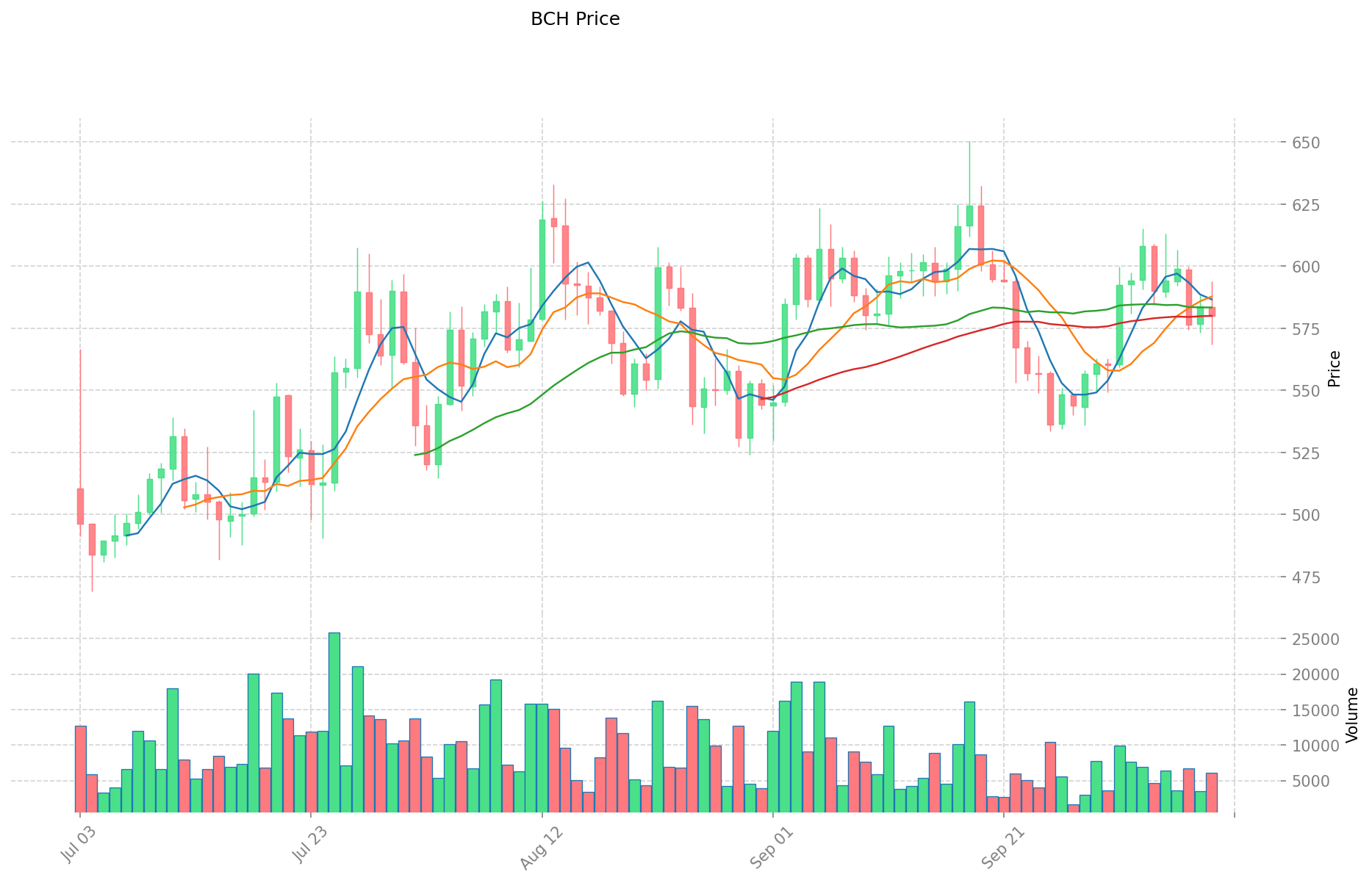MULTI vs BCH: Comparing Two Innovative Blockchain Solutions for Digital Payments
Introduction: Investment Comparison between MULTI and BCH
In the cryptocurrency market, the comparison between Multichain (MULTI) vs Bitcoin Cash (BCH) has always been a topic that investors cannot ignore. The two not only have significant differences in market cap ranking, application scenarios, and price performance, but also represent different positions in the crypto asset landscape.
Multichain (MULTI): Since its launch in 2020, it has gained market recognition for its role as the ultimate router for Web3 and cross-chain interactions.
Bitcoin Cash (BCH): Launched in 2017, it has been hailed as a peer-to-peer electronic cash system, and is one of the cryptocurrencies with the highest global trading volume and market capitalization.
This article will comprehensively analyze the investment value comparison between MULTI and BCH, focusing on historical price trends, supply mechanisms, institutional adoption, technological ecosystems, and future predictions, attempting to answer the question that investors are most concerned about:
"Which is the better buy right now?"
I. Price History Comparison and Current Market Status
MULTI (Coin A) and BCH (Coin B) Historical Price Trends
- 2022: MULTI reached its all-time high of $33.64 on January 14, 2022.
- 2017: BCH was created through a hard fork of Bitcoin on August 1, 2017, and reached its all-time high of $3,785.82 on December 20, 2017.
- Comparative analysis: In the recent market cycle, MULTI dropped from its all-time high of $33.64 to a low of $0.093819 on September 2, 2024, while BCH experienced a decline from its all-time high of $3,785.82 to a low of $76.93 on December 16, 2018.
Current Market Situation (2025-10-10)
- MULTI current price: $0.4859
- BCH current price: $580.66
- 24-hour trading volume: MULTI $17,411.40 vs BCH $3,538,576.68
- Market Sentiment Index (Fear & Greed Index): 70 (Greed)
Click to view real-time prices:
- View MULTI current price Market Price
- View BCH current price Market Price


II. Core Factors Affecting Investment Value of MULTI vs BCH
Supply Mechanism Comparison (Tokenomics)
- MULTI: Maximum supply of 1 billion tokens, with 80% held in the DAO treasury for community voting allocation
- BCH: Fixed supply of 21 million coins with halving mechanism similar to Bitcoin
- 📌 Historical pattern: BCH follows Bitcoin's halving cycles which historically create supply constraints that can drive price appreciation, while MULTI's controlled treasury release gives the DAO significant control over supply dynamics.
Institutional Adoption and Market Application
- Institutional holdings: BCH has longer history with institutional investors, while MULTI is newer but gaining traction through its DAO structure
- Enterprise adoption: BCH is more established in payment systems and retail transactions, while MULTI focuses on governance participation across multiple platforms
- Regulatory attitudes: BCH faces similar regulatory treatment to Bitcoin in most jurisdictions, while DAOs like Multichain face evolving regulatory frameworks
Technical Development and Ecosystem Building
- MULTI technical upgrades: Cross-chain interoperability focus with support for 80+ blockchains and 3,000+ tokens
- BCH technical development: Continues development on payment functionality with larger block sizes and lower fees compared to BTC
- Ecosystem comparison: BCH has more established payment infrastructure and merchant adoption, while MULTI serves as critical infrastructure for DeFi cross-chain operations
Macroeconomic Factors and Market Cycles
- Performance during inflation: BCH positions itself as "electronic cash" with fixed supply model similar to BTC's inflation hedge narrative
- Monetary policy impacts: Both assets typically show correlation with broader crypto market reactions to interest rate changes
- Geopolitical factors: BCH benefits from cross-border transaction demand, while MULTI benefits from increased demand for interoperability between different blockchain ecosystems
III. 2025-2030 Price Prediction: MULTI vs BCH
Short-term Prediction (2025)
- MULTI: Conservative $0.28 - $0.49 | Optimistic $0.49 - $0.61
- BCH: Conservative $365.82 - $580.66 | Optimistic $580.66 - $812.92
Mid-term Prediction (2027)
- MULTI may enter a growth phase, with an estimated price range of $0.39 - $0.70
- BCH may enter a bullish market, with an estimated price range of $556.56 - $870.12
- Key drivers: Institutional capital inflow, ETF approvals, ecosystem development
Long-term Prediction (2030)
- MULTI: Base scenario $0.50 - $0.69 | Optimistic scenario $0.69 - $0.76
- BCH: Base scenario $884.24 - $1065.35 | Optimistic scenario $1065.35 - $1171.88
Disclaimer: The above predictions are based on historical data and market analysis. Cryptocurrency markets are highly volatile and subject to change. This information should not be considered as financial advice. Always conduct your own research before making investment decisions.
MULTI:
| 年份 | 预测最高价 | 预测平均价格 | 预测最低价 | 涨跌幅 |
|---|---|---|---|---|
| 2025 | 0.607375 | 0.4859 | 0.276963 | 0 |
| 2026 | 0.6778305 | 0.5466375 | 0.40451175 | 12 |
| 2027 | 0.7040691 | 0.612234 | 0.38570742 | 26 |
| 2028 | 0.6778960965 | 0.65815155 | 0.4014724455 | 35 |
| 2029 | 0.708105252645 | 0.66802382325 | 0.6346226320875 | 37 |
| 2030 | 0.763751637121725 | 0.6880645379475 | 0.4954064673222 | 41 |
BCH:
| 年份 | 预测最高价 | 预测平均价格 | 预测最低价 | 涨跌幅 |
|---|---|---|---|---|
| 2025 | 812.924 | 580.66 | 365.8158 | 0 |
| 2026 | 870.99 | 696.792 | 376.26768 | 20 |
| 2027 | 870.11901 | 783.891 | 556.56261 | 35 |
| 2028 | 1042.0263063 | 827.005005 | 471.39285285 | 42 |
| 2029 | 1196.180039232 | 934.51565565 | 485.948140938 | 60 |
| 2030 | 1171.8826321851 | 1065.347847441 | 884.23871337603 | 83 |
IV. Investment Strategy Comparison: MULTI vs BCH
Long-term vs Short-term Investment Strategies
- MULTI: Suitable for investors focused on cross-chain interoperability and DeFi ecosystem potential
- BCH: Suitable for investors seeking established payment networks and potential inflation hedge properties
Risk Management and Asset Allocation
- Conservative investors: MULTI: 10% vs BCH: 90%
- Aggressive investors: MULTI: 30% vs BCH: 70%
- Hedging tools: Stablecoin allocation, options, cross-currency portfolios
V. Potential Risk Comparison
Market Risk
- MULTI: Higher volatility due to lower market cap and trading volume
- BCH: Subject to broader cryptocurrency market sentiment and Bitcoin correlation
Technical Risk
- MULTI: Scalability challenges, network stability across multiple chains
- BCH: Mining centralization concerns, potential security vulnerabilities
Regulatory Risk
- Global regulatory policies may impact both assets differently, with BCH facing more scrutiny as a payment-focused cryptocurrency
VI. Conclusion: Which Is the Better Buy?
📌 Investment Value Summary:
- MULTI advantages: Cross-chain interoperability, growing DeFi ecosystem integration
- BCH advantages: Established payment network, larger market cap, potential inflation hedge
✅ Investment Advice:
- Novice investors: Consider a smaller allocation to BCH for exposure to established cryptocurrency networks
- Experienced investors: Explore a balanced portfolio including both MULTI and BCH to capture different market segments
- Institutional investors: Evaluate BCH for its longer track record and MULTI for its potential in cross-chain infrastructure
⚠️ Risk Warning: The cryptocurrency market is highly volatile. This article does not constitute investment advice. None
VII. FAQ
Q1: What are the key differences between MULTI and BCH? A: MULTI is focused on cross-chain interoperability and DeFi ecosystem integration, with a maximum supply of 1 billion tokens. BCH is a peer-to-peer electronic cash system with a fixed supply of 21 million coins, similar to Bitcoin. MULTI is newer and more volatile, while BCH has a longer history and larger market cap.
Q2: Which coin has performed better historically? A: BCH reached its all-time high of $3,785.82 in December 2017, while MULTI's all-time high was $33.64 in January 2022. However, both have experienced significant price drops since their peaks. As of 2025-10-10, BCH is trading at $580.66, while MULTI is at $0.4859.
Q3: How do the supply mechanisms differ between MULTI and BCH? A: MULTI has a maximum supply of 1 billion tokens, with 80% held in the DAO treasury for community voting allocation. BCH has a fixed supply of 21 million coins with a halving mechanism similar to Bitcoin, creating potential supply constraints over time.
Q4: What are the main use cases for each coin? A: MULTI serves as a critical infrastructure for DeFi cross-chain operations and governance participation across multiple platforms. BCH is primarily used for payments and retail transactions, with more established payment infrastructure and merchant adoption.
Q5: How do institutional adoption and regulatory attitudes differ for MULTI and BCH? A: BCH has a longer history with institutional investors and faces similar regulatory treatment to Bitcoin in most jurisdictions. MULTI is newer but gaining traction through its DAO structure, while facing evolving regulatory frameworks for DAOs.
Q6: What are the long-term price predictions for MULTI and BCH? A: By 2030, MULTI is predicted to reach $0.50 - $0.76 in optimistic scenarios, while BCH is expected to reach $884.24 - $1171.88. However, these predictions are subject to market volatility and should not be considered financial advice.
Q7: How should investors allocate their portfolio between MULTI and BCH? A: Conservative investors might consider allocating 10% to MULTI and 90% to BCH, while more aggressive investors could opt for 30% MULTI and 70% BCH. The exact allocation should depend on individual risk tolerance and investment goals.
Share
Content